
Vergina is a small town in northern Greece, part of Veria municipality in Imathia, Central Macedonia. Vergina was established in 1922 in the aftermath of the population exchanges after the Treaty of Lausanne and was a separate municipality until 2011, when it was merged with Veroia under the Kallikratis Plan.
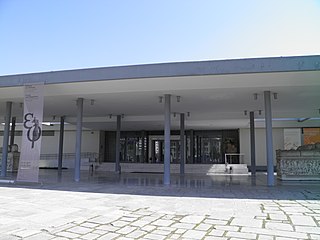
The Archaeological Museum of Thessaloniki is a museum in Thessaloniki, Central Macedonia, Greece. It holds and interprets artifacts from the Prehistoric, Archaic, Classical, Hellenistic and Roman periods, mostly from the city of Thessaloniki but also from the region of Macedonia in general.

Dimini is a village near the city of Volos, in Thessaly, in Magnesia. It was the seat of the municipality of Aisonia. The name Aisonia dates back to ancient times and it is the westernmost place in the Volos area. The Dimini area contains both a Mycenean settlement and a Neolithic settlement. The Neolithic settlement in Dimini was discovered near the end of the 19th century and was first excavated by the archaeologists Christos Tsountas and Valerios Stais.

Eordaia is a municipality in the Kozani regional unit, Greece. The seat of the municipality is the town Ptolemaida. The municipality has an area of 708.807 km2. The population was 45,592 in 2011.
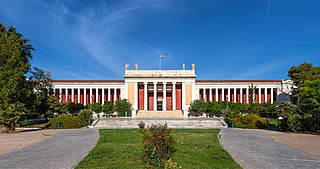
The National Archaeological Museum in Athens houses some of the most important artifacts from a variety of archaeological locations around Greece from prehistory to late antiquity. It is considered one of the greatest museums in the world and contains the richest collection of Greek Antiquity artifacts worldwide. It is situated in the Exarcheia area in central Athens between Epirus Street, Bouboulinas Street and Tositsas Street while its entrance is on the Patission Street adjacent to the historical building of the Athens Polytechnic university.

The Heraklion Archaeological Museum is a museum located in Heraklion on Crete. It is one of the greatest museums in Greece and the best in the world for Minoan art, as it contains by far the most important and complete collection of artefacts of the Minoan civilization of Crete. It is normally referred to scholarship in English as "AMH", a form still sometimes used by the museum in itself.

Aiani is a town and a former municipality in the Kozani regional unit, Macedonia, Greece. Since the 2011 local government reform it is part of the municipality Kozani, of which it is a municipal unit. The 2011 census recorded 2,006 residents in the village and 3,429 residents in municipal unit of Aiani. The municipal unit has an area of 156.004 km2, the community 52.336 km2.

Akanthos was an ancient Greek city on the Athos peninsula, on the narrow neck of land between the sacred mountain and the mainland, to the northwest of the Xerxes Canal. It was founded in the 7th century BCE as a colony of Andros, itself a colony of Chalcis in Euboea. Chalcidice was multi-cultural. The archaeology of the region suggests that some Hellenes were already there. The site is on the north-east side of Akti, on the most eastern peninsula of Chalcidice.

Delphi Archaeological museum is one of the principal museums of Greece and one of the most visited. It is operated by the Greek Ministry of Culture. Founded in 1903, it has been rearranged several times and houses the discoveries made at the Panhellenic sanctuary of Delphi, which date from the Late Helladic (Mycenean) period to the early Byzantine era.

The Archaeological Museum of Kozani is a museum in Kozani, Greece.

The Archaeological Museum of Amphipolis is a museum in Amphipolis, Central Macedonia, Greece. It is located in the archaeological site of ancient Amphipolis, near River Strymon at close range of the Thessaloniki–Kavala national highway and within the walls of the ancient city itself. In the museum, finds from Amphipolis and its surroundings are exhibited. The excavations took place mainly in the period from 1956 to 1984, under the direction of the late archaeologist Dimitris Lazaridis. After his death (1985) his daughter, Calliope Lazaridis, continued the work until 1989.

The Archaeological Museum of Delos is a museum on the island of Delos, near Mykonos in the South Aegean, Greece. It is noted for its extensive collection of statues unearthed in the surrounding area of the ancient site, which has been declared a UNESCO World Heritage Site. Although the museum has a considerable collection, it does not contain all of the items found in Delos: a large quantity are on display in Athens at the National Archaeological Museum.

The Archaeological Museum of Dion is a museum in Dion in the Pieria regional unit of Central Macedonia, Greece.

The Archaeological Museum of Eretria is a museum in Eretria, in the Euboea regional unit of Central Greece.
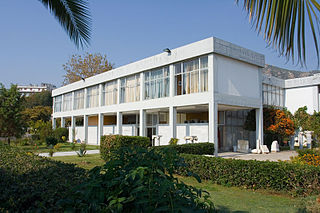
The Archaeological Museum of Kavala is a museum in Kavala, Eastern Macedonia, Greece, located towards the western end of the Ethnikis Antistasis road in Kavala.
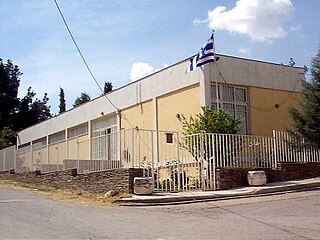
The Kilkis Archaeological Museum is located in the city of Kilkis in Central Macedonia, Greece. It opened in 1972, its purpose being to collect finds handed in by private individuals and unearthed during excavations in the Kilkis area. The exhibits are arranged in the rooms in chronological order, they date from the Neolithic to the Roman period, and they come from excavations in the settlement of Kolchida, the cemetery at Palaio Gynaikokastro, the archaeological site at Filyria, and other parts of the Kilkis Prefecture.
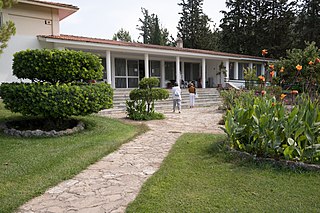
The Archaeological Museum of Nemea is a museum in Nemea, Corinthia, Greece. It was constructed by the University of California and given to the Greek State in 1984. The museum is located at the entrance to the Archaeological site of Nemea. Exhibits finds from this site and the surrounding areas, from Cooper Age (Chalcolithic) to early Byzantine era.

The Archaeological Museum of Polygyros is a museum in Polygyros, Chalkidiki, in Greece. The museum is located in Iroou Square in the town centre and displays representative archaeological finds from all over Chalkidiki. More specifically, they cover a span of time ranging from the Bronze Age to the Roman period and come from ancient Stageira, Toroni, Pyrgadikia, Aphytos, Polygyros, Ierissos, Stratoni, as also from the ancient city of Olynthos. Museum is currently closed for complete reconstruction. The Archaeological Museum of Polygyros was closed in January 2012 and reconstruction began in May 2012. Completion of reconstruction is expected sometime in summer 2014.

The Archaeological Museum of Pella is a museum in Pella in the Pella regional unit of Central Macedonia. The building was designed by architect Kostas Skroumpellos and is on the site of the ancient city of Pella. It was completed in 2009 with the support of the Greece's Third Community Support Framework.

This is a reflection of the main historical events in Pieria (Πιερία), Central Macedonia.


























